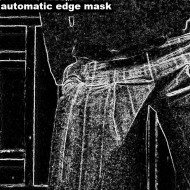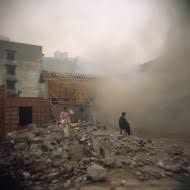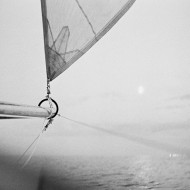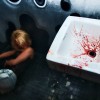Small, local markets are a mainstay in the lives of many, particularly those living in poorer countries around the world. As world food prices continue to rise these types of markets allow access to more affordable foods, and provide small producers much needed income. These images Lucas Mulder were made in the markets from Guatemala, Nicaragua, and Cuba.
Following text and photos by Lucas Mulder.
Guatemala
The first time I stepped off the bus in San Francisco el Alto, one of the largest open air markets in Central America, I purposely took a few moments to check the settings on my cameras before stepping into the craze of the market. I’d heard that early every Friday morning the whole of the town begins to transform from quiet mountain village to a crush of vendors selling everything from fruits and vegetables to livestock. As I stepped into the crowd I was immediately pulled into the rush of people moving through the streets, now market stalls. At the first intersection, more than a little overwhelmed I managed to find a place to stop for a moment, and from the corner of my eye caught the shape of a young woman approaching. As I began to lift my camera she paused, the crowd surging around her. I managed to snap a single image before she was pushed past me, and with that first chance frame my project on markets began.
Since then I have made markets a large part of my practice while working in Latin America. Guatemala, where I’m currently based, is known as the Land of Eternal Spring for it’s fertile soils, temperate climate, and abundant rainfall, and as such the markets are always overflowing with fresh produce. They are incredibly raucous places with vendors hawking prices, each competing to be louder than their neighbors. Shoppers are constantly pushing through narrow aisles, demanding tastes, haggling on prices, filling their shopping bags. At other times, on slower days, the sheer abundance can create moments of quiet for the farmers as shoppers are spread thin by choice. This play between mayhem and boredom creates an incredibly dynamic environment to work in, with a wide range of possibility.
That first day, and several visits thereafter I worked to compose every frame, but for the most part my images were failures, and I ended up frustrated. What I was looking to photograph was moving too quickly to be captured in this manner. Beyond simply documenting the physical space of the markets I wanted to look more toward the community that populated them – to take these places in from the point of view of something daily in peoples lives, rather than something spectacular in mine. After those initial visits to San Francisco I purposely began slowing down, fighting the urge to move with the crowds. I began carrying my camera low, keeping it inconspicuous with my eyes focused on what was happening around me. I increasingly started shooting from the hip, letting the images come to me rather than trying to force myself on them. Over time I’ve began to capture the moments I had sensed were waiting just under the surface of the bustle and chaos.
I’ve been working in these markets now for almost 2 years, on and off. It’s a project that I’m always coming back to, particularly if I’m feeling stuck or burned out on something else I’m working on. There’s a real beauty in all the disarray, and I’m always moved by how hard these people work, particularly the women, who are the heart and soul (as well as the backbone) of this country. In San Francisco I’m continually dodging women carrying huge loads of vegetables, rice, wheat, etc. all balanced perfectly on their heads, making a 50 kilo sack of potatoes look effortless. Most of the larger markets typically start setting up before sunrise, and there are always people tearing down their stalls long after sunset. It’s an incredible place to work, one that I can’t seem to turn away from.
Cuba
Last summer I began planning a trip to Cuba, both to photograph farming practices on the island, and to continue my work on markets there. Shortly thereafter several massive hurricanes hit the island devastating the agricultural sector, causing upwards of $5 billion dollars worth of damage. When I finally made it to Havana earlier this year, four months after the last of the hurricanes the situation was pretty dire, with most farmers still struggling to recuperate. The markets were barren, and what little was available (fast growing vegetables: potatoes, tomatoes, peppers, occasionally some fruit) was of poor quality. Everyone I spoke to felt they’d need at least another year to get back to full production, maybe more.
After having spent so much time in Guatemala it was this contrast that struck me the most, and where I focused my attention. The hurricanes combined with the financial impact of the US embargo had destroyed any sense of food security for the Cuban people. And while everyone there is entitled to a daily government ration of staples such as meat, beans, rice, etc. there are very few options available for Cubans to supplement what little they receive from the government.
The markets were also much smaller, and less busy than those I was used to, which made it was much harder to move about with the same anonymity I was used to in Guatemala. Where I was lost in the crowd before, I was now left standing out in the open. After the first day shooting I knew I needed to make a change, and began working more directly, stopping to talk and explain my project to those I was photographing more than I might have done previously. For this reason many of the images in the Cuban markets are more directly composed than those from Guatemala.
This directness also brought about the first colour images in the series. Where in Guatemala I worked to keep the focus on the moments apart from the abundance of noise and colour, in Cuba the sparseness seemed to call on colour to accentuate it.
In the end the Cuban markets left me with a very different kind of image than I was used to getting, and helped push the project further ahead in both the type of photographs taken, but also in my thinking about how to evolve them further.
Nicaragua
Being based in Guatemala gives easy access to other nearby countries, most only a couple hours travel away. Last month I traveled to Nicaragua, mostly for vacation, but I still found time to spend a few hours each day in the markets of Managua, Granada, León and Estelí.
Nicaraguan markets are more in line with those in Guatemala, they look the same, sell many of the same types of fruits and vegetables, but they still don’t have the quality nor the overall abundance. This left me photographing somewhere between Cuba and Guatemala. Nicaragua is also extremely hot, and I managed to choose the two sweatiest weeks of the year to visit, so the pace was much more sedate.
The heat also forced me indoors for much of the afternoon as it began to overpower me. That meant I would hit the markets early, first thing in the morning, and then again later in the day when they were closing down. Of all the images I took during my time in Nicaragua I think it’s these that fit best into the overall project, as there was a liveliness at these moments that played nicely against the empty (just starting, or just about to end) structures of the markets – the majority of the stalls empty, with only a very few people moving amongst them.
There was also grittiness to the physical space of these markets that I found beautiful, as many were housed in old train stations, or similarly dilapidated buildings. Where before I had been turning my attention away from the physical space, here I consciously worked to include it, walls and ceilings in particular, places where the harshness of the noon light managed to force its way through a broken roof tile, for example.
My time in Central America is quickly coming to an end, in a month or so I will be moving on. I’m working now to sequence these images into something cohesive, while trying to envision how the project will continue, wondering how markets in other countries will fit in amongst these photographs. While each country contained similar elements and themes, each brought forward it’s own distinct feeling, very different from the others. While the first chapter of this project is coming to a close, it feels as if there is still much to explore. For me these images are a testament how hard people work in their daily lives to survive, even when faced with little, or no return on their efforts. This to me is reason enough to keep moving this project forward.














































You can also subscribe to this post comments RSS feed.